Ever dreamt of wandering through the woods, gathering fresh berries and mushrooms for a delicious and free meal? For many, the idea of foraging evokes a sense of self-reliance and connection to nature. However, before you grab your basket and head outdoors, it’s crucial to understand the legal landscape surrounding foraging.
Foraging’s legality in the US depends on location, land ownership, and specific regulations. While some public lands allow limited foraging with permits, others strictly prohibit it. Private property requires landowner permission to avoid trespassing.
In the following sections, we’ll delve into the complexities of foraging regulations, explore the different types of land where foraging might be permitted, and provide practical tips to ensure your foraging activities are legal and sustainable.
The Legal Landscape of Foraging in the United States
The allure of foraging, its connection to a simpler way of life, and the potential for free, fresh food have seen a significant rise in popularity in recent years.
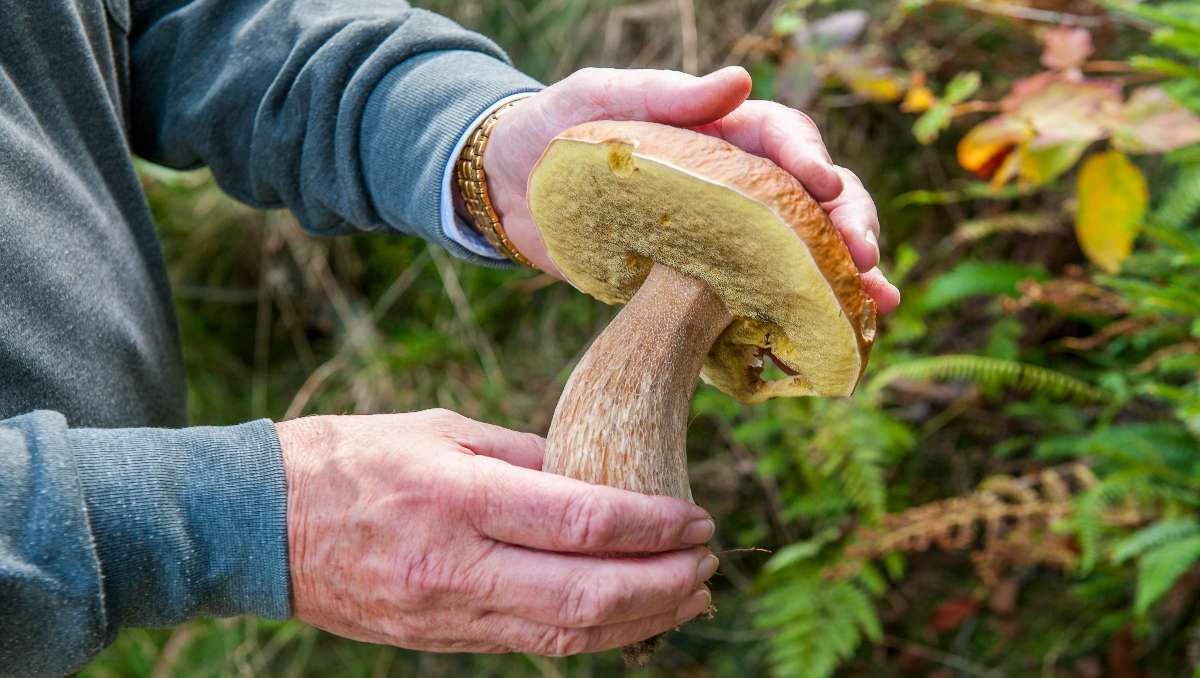
A 2023 study by the National Gardening Association found that nearly 20 million Americans participated in some form of foraging activity in the past year, with the practice becoming increasingly popular in urban areas as well. This growing trend, however, raises a critical question: is foraging legal?
The answer, unfortunately, isn’t a simple yes or no. When it comes to foraging on public lands in the United States, the legal landscape is a complex patchwork of federal regulations, state and local laws, and even individual park or land management policies.
Federal Regulations
As a starting point, it’s important to understand the overarching federal regulations governing removing natural resources from public lands.
Title 36 of the Code of Federal Regulations, specifically Part 261, explicitly prohibits the “removal of any natural product” from public lands “without specific authorization.”
This includes everything from wildflowers and berries to firewood and rocks. The rationale behind this regulation lies in the need to protect the ecological balance and ensure the sustainability of these public lands for future generations.
State and Local Laws
While Title 36 provides a foundational framework, the specific legal framework for foraging becomes even more intricate at the state and local levels. Each state has its own set of regulations and permitting systems that govern the collection of wild plants and mushrooms on public lands.
Individual park management agencies within these lands, such as the National Park Service (NPS) or the Bureau of Land Management (BLM), may have even more specific regulations and permit requirements in place.
For instance, while the NPS generally prohibits the removal of plants and wildlife from national parks, some parks may have designated areas where berry picking or mushroom foraging is allowed with a permit. Similarly, certain national forests managed by the BLM may allow for limited personal use foraging of specific plant species, requiring a permit or adhering to specific seasonal restrictions.
It’s crucial to remember that park superintendents often hold significant discretion in determining the rules and regulations surrounding foraging within their jurisdiction. This means that foraging regulations vary slightly from park to park, even within the same state or federal agency.
Where is Foraging Allowed?
Now that we’ve explored the legal complexities surrounding foraging, the next crucial question is: where can you actually forage? Understanding the different land ownership types and their associated regulations is paramount for responsible and legal foraging.
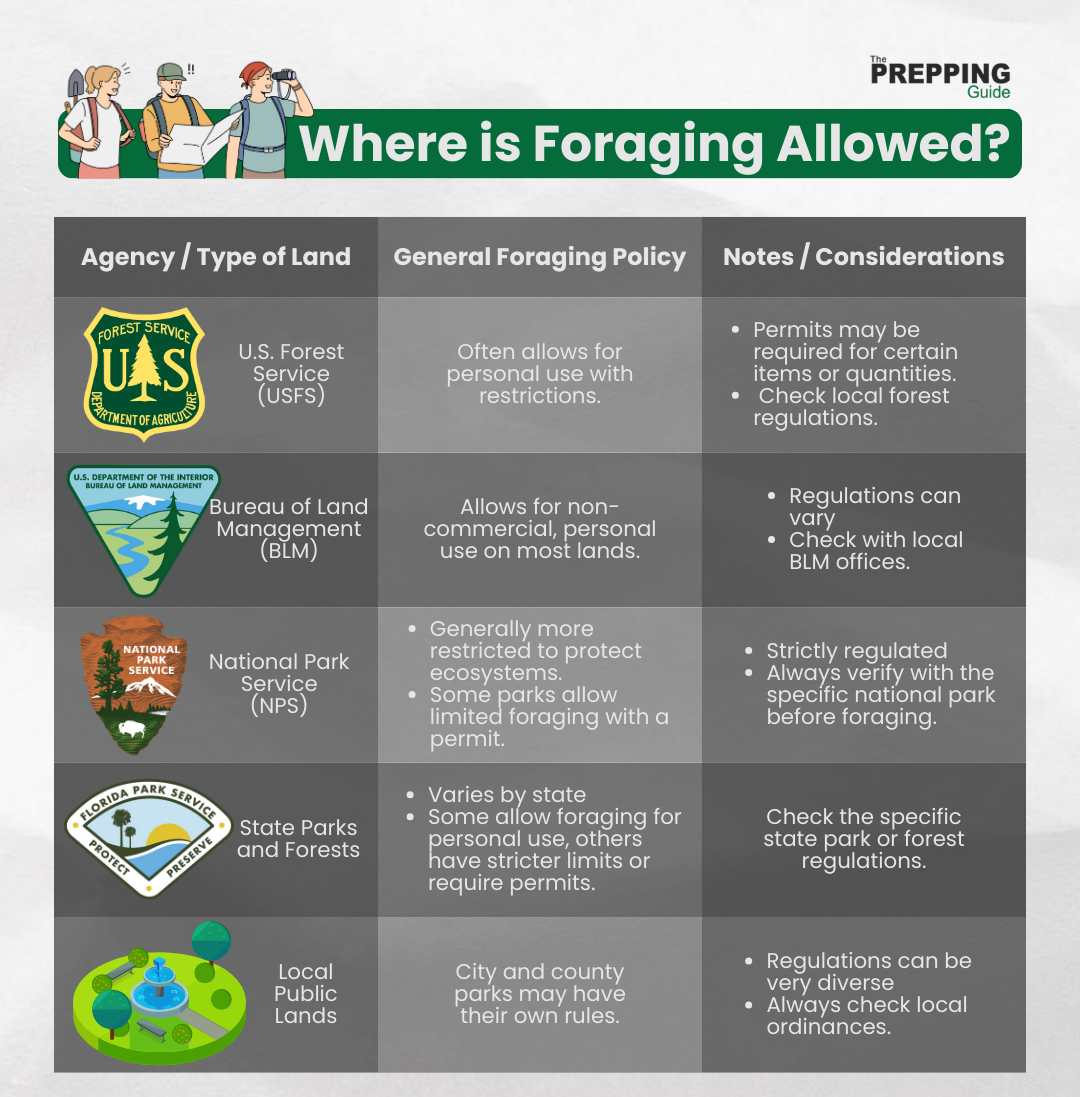
Public Land
Public lands, encompassing national parks, state parks, forests, and wildlife management areas, often represent the most accessible locations for potential foraging activities. However, as we learned earlier, foraging on public land is not a blanket right. While some public lands may allow limited foraging with permits or under specific guidelines, others strictly prohibit it.
The key lies in researching the specific regulations and obtaining the necessary permits for the public land you intend to visit. This can be done by visiting the website of the managing agency (e.g. National Park Service, Bureau of Land Management) or contacting the park ranger station directly.
Private Land
While public lands may offer some foraging opportunities, it’s important to remember that private property is strictly off-limits. Regardless of whether the land appears abandoned or the specific plants and mushrooms appear abundant, foraging on private land without the explicit permission of the landowner is considered trespassing.
Even if taking a few berries or mushrooms might not be considered theft in the strictest legal sense, it still violates the landowner’s property rights.
The consequences of trespassing can range from being politely asked to leave the property to facing fines or even criminal charges.
Therefore, it’s essential to always seek permission from the landowner before foraging on any private property. Responsible and respectful interaction with landowners is crucial for fostering positive relationships and gaining access to private foraging opportunities in the future.
Foraging Guidelines by Region
The United States boasts diverse ecosystems, each harboring a unique selection of edible plants and mushrooms. While the legalities of foraging are paramount, understanding the regional variations in forageable species and seasonal considerations can elevate your experience and ensure sustainable practices.
Let’s delve into some key foraging opportunities and tips by region:
Northeast
Foraging opportunities: Wild blueberries, raspberries, blackberries, fiddlehead ferns, chanterelle mushrooms, morel mushrooms (spring)
Seasonal tips: Spring offers a bounty of fiddleheads and early morel mushrooms. Summer brings forth blueberries, raspberries, and blackberries. Be mindful of strict regulations and designated foraging areas in national parks like Acadia National Park.
Southeast
Foraging opportunities: Mayapples (fruit in late spring), pawpaws (fruit in fall), wild garlic, chanterelle mushrooms, hen-of-the-woods mushrooms
Seasonal tips: Spring offers wild garlic and early mushrooms. Summer brings forth mayapples and abundant greens. Fall is prime time for pawpaws and many other edible nuts. Be aware of the potential presence of invasive lionfish in coastal areas, which can be poisonous if consumed.
Midwest
Foraging opportunities: Dandelions (leaves and flowers), wild blackberries, elderberries (fruits in fall), morel mushrooms, puffball mushrooms
Seasonal tips: Early spring is the time for dandelion greens and flowers. Summer offers blackberries and elderflowers. Fall brings forth elderberries and various mushrooms. Be mindful of agricultural practices and avoid foraging near conventionally sprayed fields.
West
Foraging opportunities: Prickly pear cactus pads (fruits in fall), wild asparagus, pine nuts (fall), chanterelle mushrooms, matsutake mushrooms (fall)
Seasonal tips: Spring offers wild asparagus in desert regions. Summer brings forth prickly pear cactus pads (fruits only after removing spines). Fall is prime time for pine nuts and many other edible mushrooms. Be aware of the potential presence of rattlesnakes in certain areas, especially during warmer months.
Here’s a table outlining foraging guidelines by region in the US, including the states within each region and general foraging opportunities:
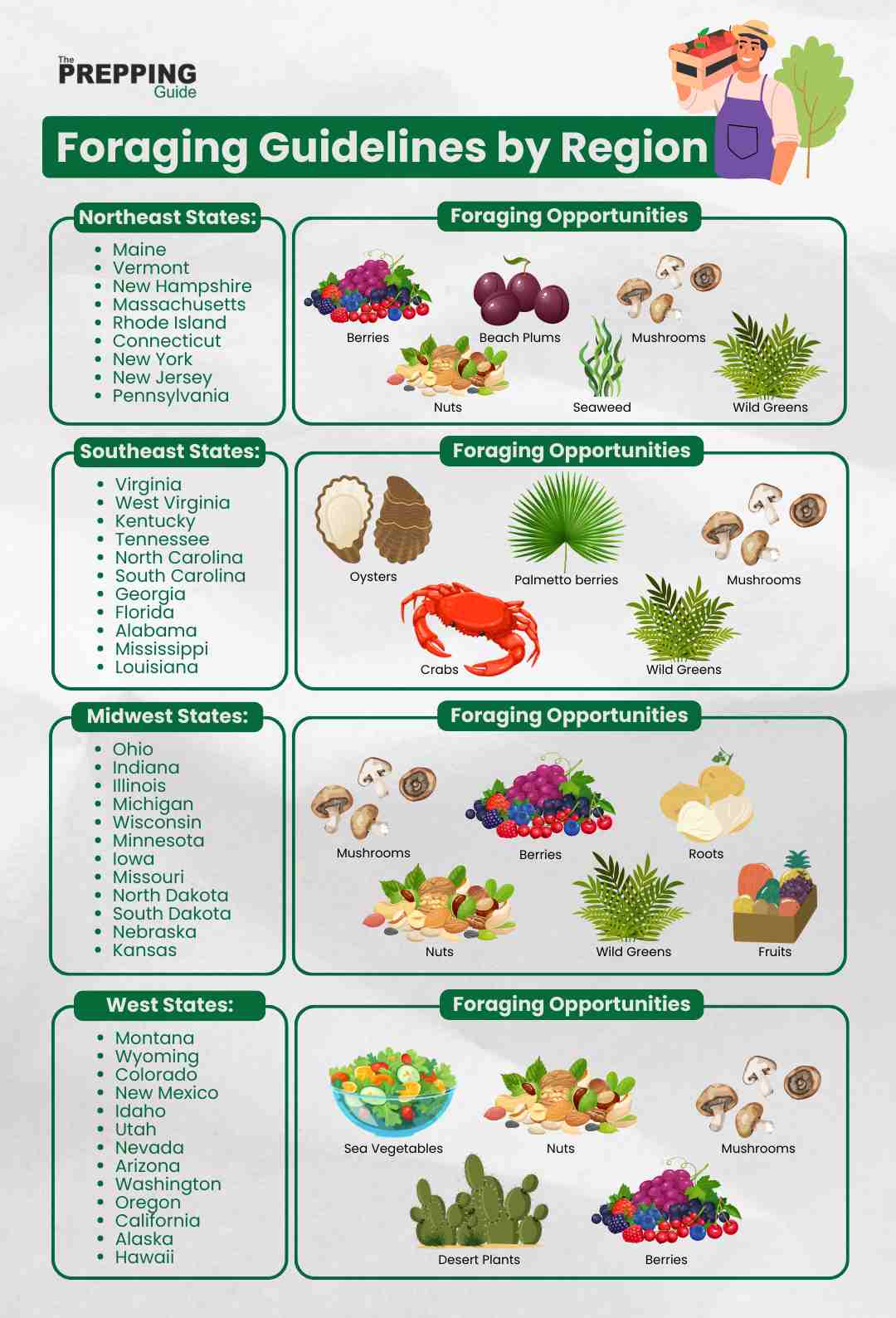
Remember: This is just a glimpse into the diverse world of regional foraging. It’s crucial to conduct thorough research on specific species, their identification characteristics, and any potential lookalikes before consuming any wild plant or mushroom. Additionally, always prioritize the health of the ecosystem and never take more than you need.
Is Foraging Dangerous?
When approached with the proper knowledge and respect, foraging can be a safe and rewarding experience. However, it is essential to acknowledge that inherent risks are involved, and certain precautions must be taken to minimize potential dangers.
Here are some key factors to consider:
1. Misidentification: One of the most significant dangers associated with foraging is the risk of misidentification. Many edible plants and mushrooms have poisonous look-alikes, and even a small mistake can lead to serious illness or even death. It is crucial to never consume any wild plant or mushroom unless you can definitively identify it with 100% certainty.
Here are some examples of commonly encountered poisonous plants in North America:
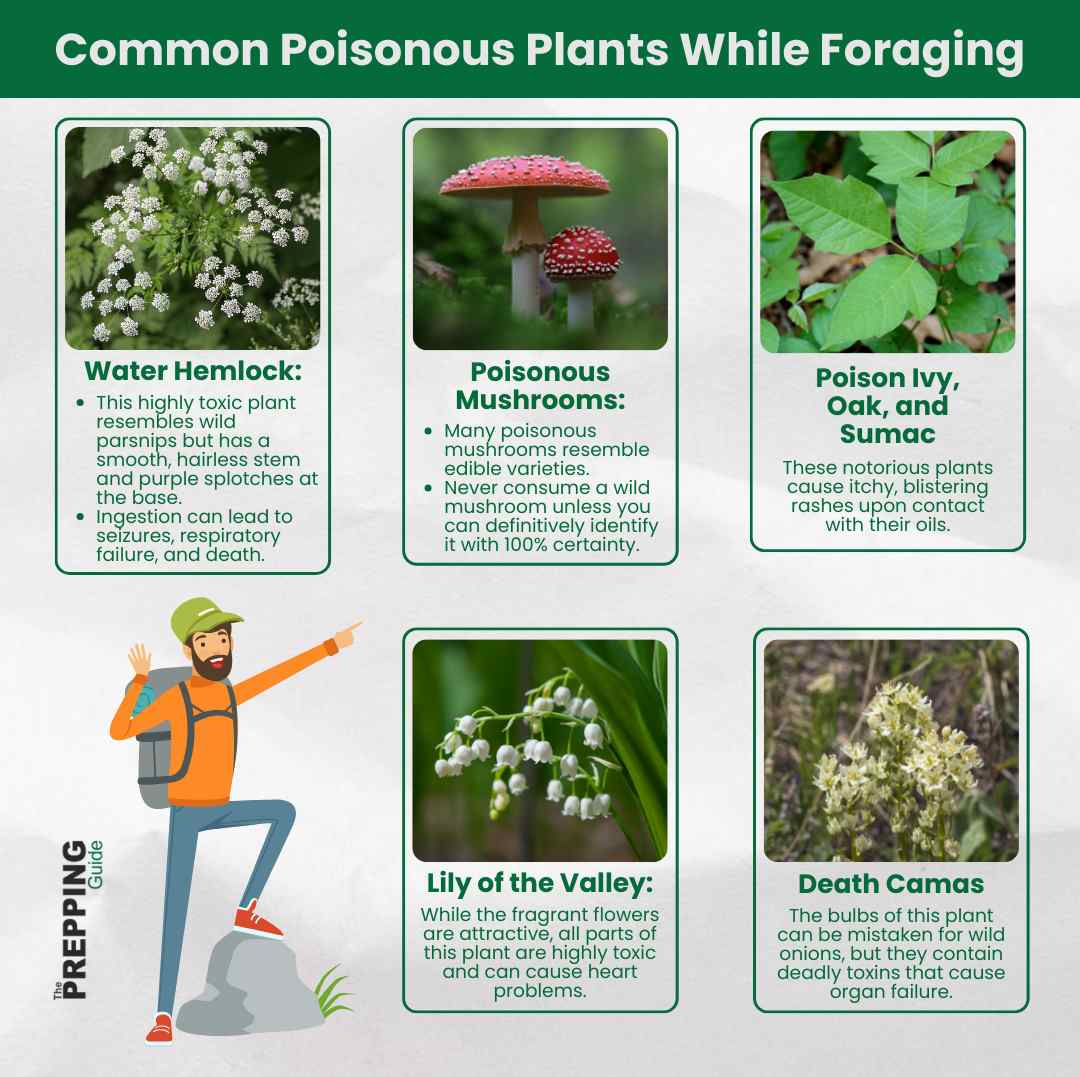
2. Contaminants: Even correctly identified plants and mushrooms can be dangerous if contaminated with pesticides, herbicides, or other harmful substances. Avoid foraging near heavily trafficked areas, agricultural fields, or industrial sites, as these areas are more likely to have harmful contaminants in the soil and plants.
3. Allergic reactions: Individuals with allergies to certain plants or pollen should exercise extreme caution when foraging. Even a small amount of an unknown plant can trigger a potentially life-threatening allergic reaction.
4. Wildlife encounters: Depending on the location, foraging might involve venturing into areas inhabited by wild animals. While most encounters are unlikely to be dangerous, it’s crucial to be aware of your surroundings, exercise caution, and avoid disturbing wildlife.
5. Overconsumption: Even edible plants and mushrooms can be harmful if consumed in excessive quantities. Understanding the proper dosage for each species is essential, and never overindulge, especially when trying something new for the first time.
What is Responsible Foraging?
While the allure of foraging lies in its potential bounty, it’s crucial to remember that responsible practices are paramount to ensure a sustainable and ethical experience.
Responsible foraging goes beyond simply knowing which plants and mushrooms are edible. It encompasses respect for the ecosystem, ethical harvesting techniques, and ensuring the longevity of the resources you seek.
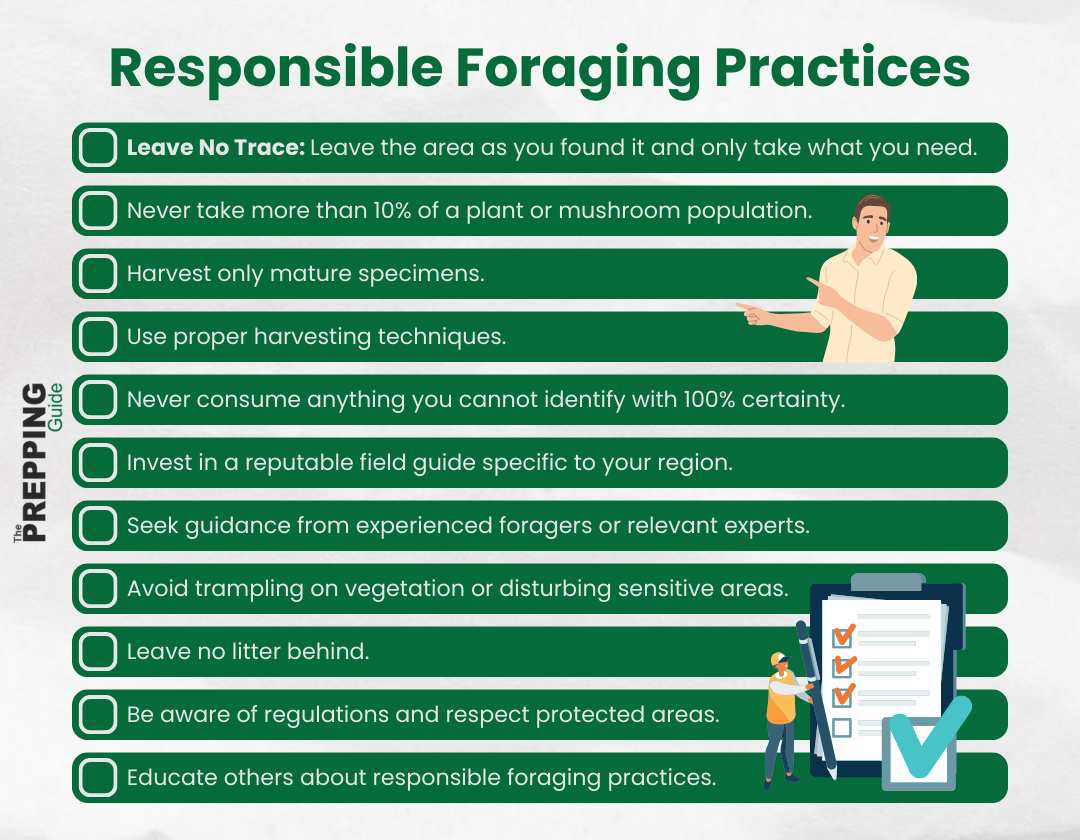
Sustainable Harvesting: Responsible foraging begins with sustainable harvesting practices. The goal is to take what you need without jeopardizing the future viability of the plant or mushroom population.
The leave-no-trace framework emphasizes minimizing your impact on the environment. Apply these principles by leaving the area as you found it, avoiding disturbing wildlife, and only taking what you need.
Consequently, never take more than 10% of a plant or mushroom population. This ensures enough resources are left for the ecosystem to thrive and allows future generations to enjoy the same experience. Allow young plants and mushrooms to reach maturity and reproduce, ensuring the population’s long-term health.
When harvesting, avoid damaging the root system of plants by carefully cutting or digging them up with minimal disruption.
Species Identification: Accurate identification is the cornerstone of responsible foraging. Consuming an unknown plant or mushroom, even if it appears harmless, can have severe consequences.
To ensure safety, never consume anything you cannot identify with 100% certainty. Even a small mistake can be life-threatening. Invest in a reputable field guide specific to your region. These guides provide detailed information on identifying edible and poisonous species. Seek guidance from experienced foragers or relevant experts. Learning from individuals with extensive knowledge can significantly mitigate the risk of misidentification.
Respecting the Environment: Beyond harvesting practices and identification, responsible foraging necessitates respecting the environment you are exploring.
Be mindful of your surroundings. Avoid trampling on vegetation or disturbing sensitive areas. Pack out all your trash and any potential debris, leaving the area pristine. Be aware of regulations and respect protected areas. Some areas may have restrictions on foraging, so research and adhere to local regulations.
By embracing these principles, you can ensure that your foraging activities are not only safe and enjoyable for yourself but also contribute to the well-being of the environment and the delicate balance of the ecosystem.
Responsible foraging is about fostering a symbiotic relationship with nature, taking what you need while ensuring its continued abundance for generations to come.
Foraging Tips
Now that you’ve gained a comprehensive understanding of the legalities, risks, and responsibilities associated with foraging, here are some practical tips to help you embark on a safe and successful foraging adventure.
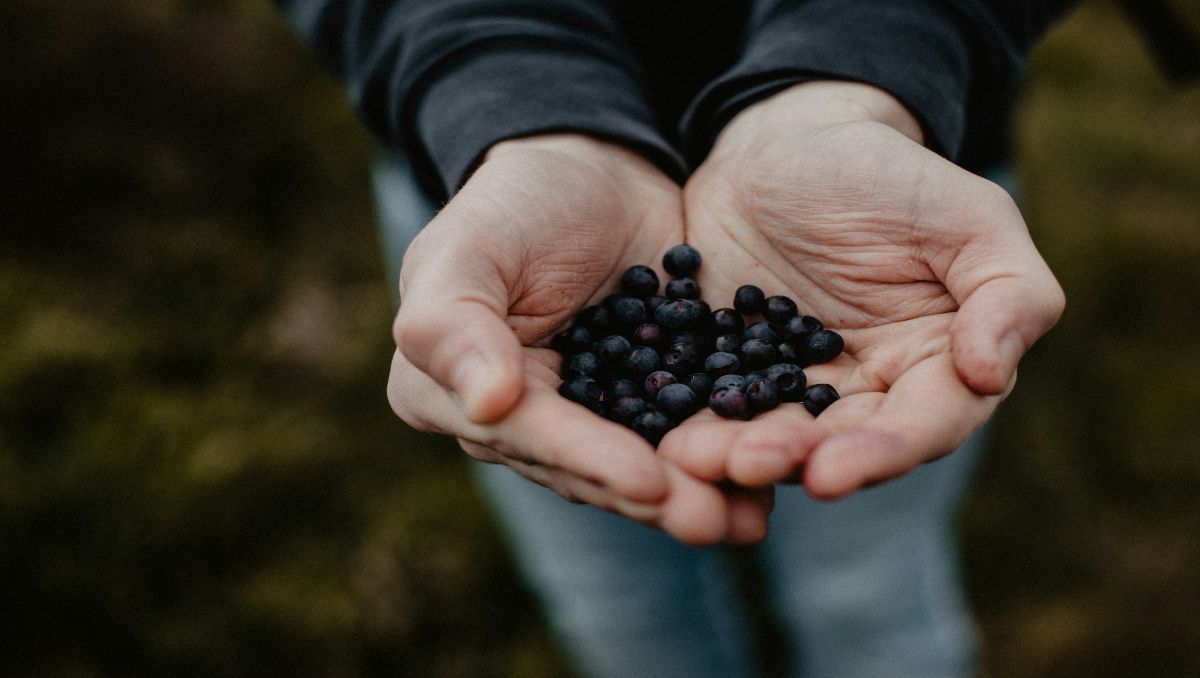
Preparation
- Do your research: Before venturing out, thoroughly research your region’s edible plants and mushrooms. Familiarize yourself with their identification characteristics, potential lookalikes, and harvesting guidelines. Utilize reputable field guides and online resources from trusted organizations, and seek guidance from experienced foragers when possible.
- Plan your trip: Choose a location suitable for foraging, considering accessibility, regulations, and permitted species. Ensure you have the necessary permits or landowner permission if venturing onto private property.
- Gather the right tools: Pack a sturdy basket for collecting your finds, a sharp knife for harvesting, a field guide for quick reference, and a camera to capture detailed images of the plants or mushrooms you encounter.
While Foraging
- Start slow and focus on a few species: As a beginner, gradually building your confidence and identification skills is crucial. Don’t overwhelm yourself by attempting to identify and harvest numerous unknown plants or mushrooms at once.
- Observe carefully: Pay close attention to the physical characteristics of the plant or mushroom. This include the size, shape, color, texture, and any distinguishing features. Consult your field guide or reliable online resources to confirm your identification.
- When in doubt, throw it out. If you are unsure about the identity of a plant or mushroom, even after consulting your resources, err on the side of caution and discard it. It’s never worth risking your health to consume something you cannot definitively identify.
- Respect the ecosystem: Practice sustainable harvesting techniques, as mentioned earlier. Take only what you need, avoid damaging the surrounding environment, and leave no trace of your presence.
After Foraging
- Double-check your identification. Before consuming your foraged treasures, perform a final identification check at home using reliable resources or consult with an experienced forager.
- Properly clean and prepare your finds. Depending on the species, cleaning, and preparation methods will vary. Research proper cleaning and preparation techniques for each edible plant or mushroom you harvest.
- Start small and enjoy! When consuming your foraged bounty, begin with small quantities, especially if you are trying a new species for the first time. This allows you to monitor your body’s reaction and avoid potential adverse effects.
By following these tips and prioritizing responsible practices, you can transform foraging into an enriching experience that allows you to connect with nature while enjoying its edible treasures. Knowledge, caution, and respect for the environment are the cornerstones of safe and sustainable foraging.
A Final Note on Legal and Responsible Foraging
When approached with the proper knowledge, respect, and caution, foraging can be a deeply rewarding experience. It allows you to connect with nature and enjoy its diverse bounty. It can also be a source of fresh, healthy food, a fun outdoor activity, and a way to learn valuable skills about plant and mushroom identification.
However, it’s crucial to remember that responsible foraging practices are paramount. By understanding the legal landscape, identifying edible species accurately, and adhering to sustainable harvesting techniques, you can ensure your foraging activities are safe and ethical and contribute to the ecosystem’s health.
The Prepping Guide empowers individuals with the knowledge and skills to navigate the world confidently and self-reliant. Whether you’re interested in learning more about foraging, wilderness survival, or other preparedness topics, The Prepping Guide provides comprehensive resources, expert advice, and practical tips to help you be prepared for any situation.
